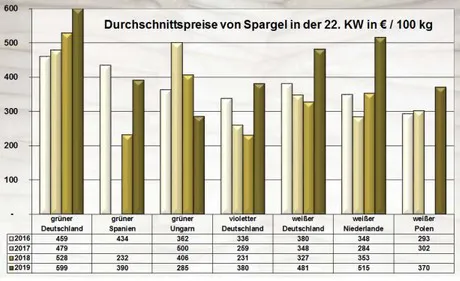The supply of asparagus was usually too lush. Certainly at the start, demand did not develop to the necessary extent. It therefore often came to stocks, which meant a corresponding discharge pressure. At least the upper limits of the price margins had to be lowered. Up to the intensification of demand just the holidays, prices had to be lowered. But despite increased sales, higher prices could rarely be established. Supply and demand simply did not correlate. Price reductions could not be avoided.

Traders remained unable to raise their prices, as the customers' thirst for the product was totally unrelated to their willingness to pay more. The marketing of green stems was more balanced, in most places.
Apples
In general, the number of German sales has been decreasing in a similar way to that of the Italian and French. With attractive organoleptic features, they did not need to fear competition from the southern hemisphere. Their prices hovered at a constant level.
Pears
Generally, sales were rather quiet. Since demand was largely matched, prices needed to be modified gradually. At times, demand was quite satisfactory. Occasionally, opportunities for higher prices opened up.
Table grapes
The European campaign started with Italian dark Black Magic and Victorias. The prices moved in a wide range between a rather meager €4 and quite a respectable €6 per kg. For the first time, Egypt sent small shipments.
Strawberries
At the beginning, it was a stop-and-start business. Moreover, availability increased. The prices showed a declining trend. On several occasions before the holiday, however, demand increased significantly, allowing traders to raise their prices.
Lemons
The Spanish shipments dominated the monopoly trade. Increasing volumes of Verna increasingly replaced the declining influx of Primofiori. This allowed traders to locally raise prices.
Bananas
Usually, the influx of goods correlated with that of sales opportunities. As a result, prices mostly moved within an unchanged, relatively narrow range. For preferred second and third brands, it was not possible to establish higher prices.
Cauliflower
The offer was generally manageable. At the same time, demand began to intensify due to the cooler weather. The prices remained at least at their previous level, sometimes rising slightly.
Lettuce
The deliveries of local ice berg lettuce were noticeably expanding, and Spanish shipments were very present. Dutch quantities rounded off the product range. Because of the increased inflow, prices had to be lowered somewhat.
Cucumbers
On the one hand prices improved. On the other hand, a greater availability led to lower prices. However, prices were soon to rise more clearly, as traders were increasingly able to cope with the high volumes.
Tomatoes
The extended offer did not correlate with the slow demand at all. The main contributors were Belgium and the Netherlands. Domestic quantities also increased. This led to an obvious oversupply, which forced prices down.
Sweet peppers
Almost everywhere, prices were uneven: some remained constant and some oscillated quite a bit. The green products usually became cheaper as the red and yellow varieties became more expensive. Locally, prices of the red batches dropped off.
